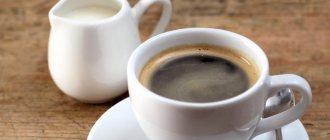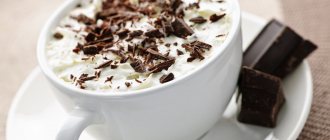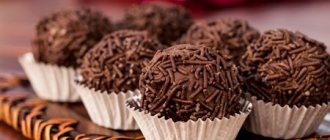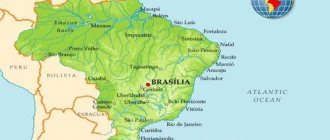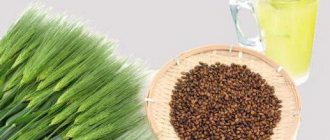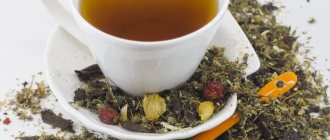When you wake up in the morning, or feel low in energy after lunch, what do you prefer as a source of energy: coffee or an energy drink? You may just need a good dose of caffeine, but it's the way you get it that really matters. Some people choose Red Bull, Monster, Adrenalin Rush, Burn or other drinks, others pour themselves another shot of espresso. We looked at the main parameters of both types of drinks to determine which is more harmful: coffee or energy drinks.
Calorie content of coffee and energy drinks
A high calorie count doesn't necessarily mean a food or drink is unhealthy (after all, your body needs calories to function properly). However, it's important to remember where you get your calories from and look for healthy, wholesome sources.
For comparison:
- There are no calories in coffee. More precisely, there are, but in a serving of espresso (or Americano) there are only 2 of them, and in a shot of espresso (or Americano), it’s good if there are 4-5. Given the daily norm of even the most strict diet of approximately 1500 kcal, this is generally unimportant.
- A can of a typical energy drink like Monster contains 110 calories, which mostly come from added sugar.
Sugar has calories, but you won't get any beneficial nutritional value for your body; it's a fast carbohydrate. Coffee is better for long-term activity, and you don't have to count the number of calories in it.
Sugar content in coffee and energy drinks: which is more harmful?
- Even if energy drinks are advertised as “sugar-free,” they contain artificial sweeteners, which are best avoided from your diet anyway.
- One Red Bull (250 ml) contains 26 grams of added sugar, which is more than half the recommended daily amount in a typical 2,000-calorie diet.
- Sugar-free versions of energy drinks are not very good for you because they contain artificial sweeteners such as aspartame and sucralose.
- But coffee can still be sweet and low in calories: try all-natural stevia instead of sugar and replace the cream with almond milk, which has a great taste, aroma and slight natural sweetness.
If you're concerned about your sugar intake, add just a spoonful of sugar or a natural sweetener to your coffee.
Harm and side effects
Now we are not talking about low-alcohol energy drinks (after all, it is already known that alcohol together with caffeine provoke an increase in blood pressure, vasospasm, and convulsions). Excessive consumption of non-alcoholic energy drinks is fraught with the following consequences and side effects:
- Circadian rhythm (sleep) disorder
- Insomnia
- Tachycardia
- Arrhythmia
- Hyperglycemia (high sugar)
- Metabolic disease
- Psychomotor disorders
- State of anxiety and restlessness
- Nausea, diarrhea, vomiting
- Frequent urination
- Obesity
- Deterioration of the condition of teeth, skin, hair, nails
- Dehydration
- Nervousness
- Tremor in the limbs
- Getting used to the drink
Where is there more caffeine in coffee or energy drinks?
If you think that energy drinks contain more caffeine because it makes you feel more alert, this is not true. A standard 250-gram can of Red Bull has 80 mg of caffeine, while a large Americano from a machine has about 90 mg. Unless you're drinking from a large can, the amount of caffeine will be roughly comparable. There are energy drinks with an increased dose of caffeine, and there is decaf coffee. Keep in mind that a healthy adult can consume up to 400 mg of caffeine per day. In situations of stress or fatigue, this dose is reduced.
To avoid an attack of tachycardia, tremors in the hands and general weakness, it is worth controlling the amount of caffeine you get from any drink.
Although coffee contains more caffeine, additives in energy drinks, such as taurine, act as enhancers that can help avoid energy crashes and enhance athletic performance. So if you need a caffeine boost before you hit the gym, an energy drink can help you perform better in the gym.
A frequently asked question is: how many cups/mugs of coffee are there in energy drinks, which is more harmful? The answer is about one cup per 250ml jar.
Taurine
Perhaps the most mysterious substance contained in most energy drinks. But many of us don't even know what it does. In fact, the issue is controversial. It seems that taurine promotes energy exchange in the body and has a tonic effect on the nervous system - that is, it calms.
It may seem strange that such a thing was put in a drink that is supposed to invigorate. But taurine doesn't slow you down so much as it makes you feel calmer. The more taurine, the smoother the effect will be on you. But don't think that this is a mega-safe thing. Taurine is extremely harmful for those who have problems with the kidneys and intestines.
The most taurine energy drink is, of course, Red Bull. Insane 400 mg per 100 ml. This means that from two half-liter jars you will get 4 grams of taurine, which is one gram more than the daily value for an adult. But how soft it goes!
What is better in composition, what is more harmful: energy drink or coffee
By drinking espresso or Americano you, of course, will not get taurine, ginseng, mate and B12.
The good news is that you don't need nearly as much of these stimulants and vitamins on a daily basis. Some are designed to enhance the effects of caffeine, while others are added because it sounds good, even when there is no clear scientific evidence to support its effectiveness. Energy drinks contain a long list of ingredients such as glucose, sodium citrate, and artificial colors and flavors. They also usually contain extra vitamins, such as B12 and calcium, which should help give you an energy boost. However, your body does not absorb added vitamins that are naturally found in whole foods, so you should not rely on these added vitamins when making your choices.
Of course, B12 is a healthy and important vitamin, but most people get enough of it from their regular diet.
Coffee just contains coffee. Well, yes, Arabica contains more than 2000 compounds, but no one added anything synthetic or unnecessary to it for greater benefit. If you order coffee cocktails, the list of ingredients, of course, expands, but you can still choose a pure black at any cafe.
Four elements
Let's start with the fact that tonic drinks are not intended to quench thirst, but to maintain the physical and mental strength of a tired person who does not have the opportunity to rest . This task is as old as time. People have been cheering themselves up for a long time. The most common stimulant was caffeine. Its source in India and the Middle East was coffee; in China, India and Southeast Asia - tea; in America - the yerba mate plant, cocoa beans, guarana leaves and cola nuts. Other tonic plants were also used, including ginseng, eleutherococcus, and Rhodiola rosea. In medieval Japan, sweet energy drinks with ginseng extract were very popular. The first information about them appeared in the 18th century, and their industrial production began in the 20th century. These drinks are still very popular in Southeast Asia.
The appearance of energy drinks in Europe is associated with the name of the Austrian entrepreneur Dieter Mateschitz. In 1984, he became acquainted with Asian energy drinks, appreciated them and modernized them to suit European tastes. In 1987, the first non-alcoholic energy drink, Red Bull Energy Drink, appeared on the European market, carbonated and with less sugar than its Asian prototype. Then American and Pepsi-Cola released their own brands of non-alcoholic energy drinks, and now there are much more manufacturers. The recipe for drinks varies, but they always include tonic components, amino acids, B vitamins and carbohydrates.
Carbohydrates, glucose and sucrose serve as sources of energy. Glucose in the body breaks down quickly, sucrose takes a little longer. Carbohydrates also include a glucose derivative - glucuronolactone, which promotes the removal of metabolic products. Half a liter of energy drink contains about 54 grams of sugars, that is, a quarter cup. Responding to the demands of the times, most manufacturers are producing low-calorie tonic drinks without sugar, with artificial sweeteners, and energy drinks without an energy source have joined the list of such strange products as non-alcoholic beer and decaffeinated coffee.
B vitamins (niacin, pantothenic acid, vitamins B6 and B12) improve cognitive function and stimulate metabolism. By participating in the breakdown of proteins, fats and carbohydrates, they contribute to the release of energy. A separate line on the list is inositol, or vitamin B8, which protects cell membranes from damage, stimulates mental activity, improves concentration and memory, reduces brain fatigue, and helps survive stress. Inositol is recommended to be taken during exams.
The main amino acids in energy drinks are L-carnitine and taurine. Carnitine is synthesized in the body and is involved in lipid (fat) metabolism. In addition, L-carnitine stimulates hematopoiesis, prevents the formation of blood clots, and helps restore strength after heavy physical exertion.
Taurine is a derivative of the amino acid cysteine, its name comes from the Latin “taurus” - ox, because taurine was first isolated from bovine bile extract. This is a very common compound that is synthesized in the body of most mammals and is present there in significant quantities (in humans - 1 g per 1 kg of live weight). Taurine increases physical endurance and stress resistance, participates in the supply of hemoglobin to tissues, promotes the breakdown of fatty acids and the removal of harmful substances.
The main tonic component of the vast majority of energy drinks is the plant alkaloid caffeine. Caffeine gently stimulates the central nervous and cardiovascular systems, helps to concentrate, improves performance and increases endurance. Some energy drinks also contain other tonic ingredients, most often ginseng and eleutherococcus. Guarana extract, the main source of caffeine added to energy drinks, contains, in addition to caffeine, the alkaloids theobromine and theophylline.
Caffeine content in different products
The components of energy drinks are selected in such a way as to quickly release energy from sugars and a person’s own fat reserves and accelerate the elimination of metabolic products. Their combination should make drinking the drink as effective, enjoyable and safe as possible. Now we'll talk about safety.
Different quality of energy in coffee and energy drinks
Coffee can charge you with both mental and physical energy. While sipping a fragrant Americano, most people are able to concentrate perfectly, whether on work projects or driving. From this point of view, coffee is perfect for office workers, students, and in any situations where you need to be attentive and concentrated.
Energy drinks, according to many people, provide physical energy due to the large amount of sugar and stimulating additives. They also “bring you to your senses,” but at the same time it is often impossible to do creative work, complete a coursework, or come up with a presentation. I don’t want to sleep, but I don’t have concentration either, there is only the physical energy of the body.
Mixing two different types of stimulants to get the maximum effect from each is not recommended.
For whom are energy drinks contraindicated?
Not everyone can drink energy drinks. For example, they are completely contraindicated during pregnancy and breastfeeding, as well as for children under 14 years of age. Due to stimulation of metabolic processes and activation of brain activity, energy drinks are prohibited for people with mental and neurological disorders. They are also not recommended for patients with serious heart and gastrointestinal diseases.
If you really need to cheer up, increase concentration and relieve fatigue, it is better to use safer methods. In particular, it is necessary to provide the body with a good night's rest and spend more time in the fresh air. It is better to replace energy drinks with herbal and vitamin teas, fruit juices or clean water. It is also necessary to adhere to the principles of proper nutrition and engage in moderate physical activity.
By following these simple rules, you will be able to completely eliminate the need to use energy drinks without loss of vigor and performance.
Prices for coffee and energy drinks: which is more harmful to the budget?
250-330 ml cans of Red Bull or Burn cost approximately 90–100 rubles. Do you need two jars overnight? For 150–200 rubles you can buy a 250 gram pack of coffee. If you consider that for one cup the standard amount of ground coffee is 7 g (a heaping teaspoon or one pour into the coffee machine), it turns out that you get approximately 35 cups from one pack. So if we are talking about budget and savings, the question of what is worse, coffee or energy drink, is not even worth it.
If you buy a drink in a coffee shop (like you would grab an energy drink in a store), a serving of Americano will cost the same 80–100 rubles. But without chemical additives, a natural product. If you buy a drink from a coffee machine in a store, it will be even cheaper.
Sugar
One of the most dangerous elements of energy drinks. Especially if you are watching your figure. In a half-liter can of Red Bull there are as many as 54 grams of sugar, that is, 14 teaspoons. So if you are charging, then give up sugar in other foods on this day. And not just because of the calories.
Firstly, an excess of sugar will at some point make you sleepy, which doesn’t really fit with the main purpose of energy drinks. Secondly, a drink that is too sweet will simply make you sick. Especially after several jars.
One of the sweetest energy drinks is “Rockstar”, popularly known as “YAR” because of its stupid design. 60 g of sugar per 0.5 liter is catastrophically too much. But don't drink it in general, it's disgusting.
Luckily, there are sugar-free options - Red Bull Blue with aspartame and Black Monster Ultra with sucralose. It won't be as tasty, but it will be safer. But normally, you just look at the jar and figure out how many glazed donuts are in it. I have already given you the guideline.
Let's sum it up
- There are no calories in coffee, and about 100 kcal in energy drinks per 250-gram jar.
- Your Americano can be sweetened with natural stevia. The finished product contains either a lot of sugar or artificial sweeteners.
- In terms of caffeine, drinks are approximately the same, but artificial additives often enhance its effect, so the answer to the question of what is more effective, what invigorates better, coffee or energy drink, is ambiguous.
- If we talk about the composition, you yourself understand what is healthier – natural coffee or synthetic energy drink.
If you have no other choice, there's nothing wrong with drinking energy drinks every now and then—it's almost like drinking soda. But if you have the opportunity and you are wondering which is more harmful, coffee or energy drinks, choose coffee because it is a natural source of caffeine. If you drink your coffee black, you don't have to worry about calories, sugar, or additives.
Advantages and Disadvantages of Quitting Caffeine
Caffeine is only effective if you consume it only occasionally. But if you are a daily coffee drinker, you will start to feel uncomfortable when you give it up.
Headache, decreased activity, insomnia are the consequences of abrupt caffeine withdrawal. Usually such symptoms disappear after three to four days.
Conclusion
The amount of caffeine depends on the quality of the product and the brewing method. As you can see from the caffeine content table, instant coffee generally does not contain much more caffeine than black tea. When taking energy drinks, the effect of caffeine becomes more pronounced.


